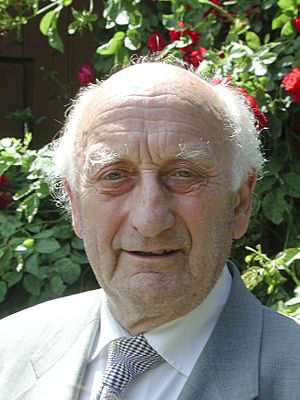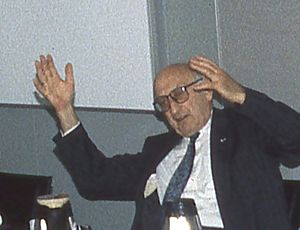Friedrich L. Bauer facts for kids
Quick facts for kids
Friedrich Ludwig Bauer
|
|
|---|---|
 |
|
| Born |
Friedrich Ludwig Bauer
10 June 1924 |
| Died | 26 March 2015 (aged 90) |
| Education | Ludwig-Maximilians-Universität |
| Known for | Stack (data structure) Sequential Formula Translation ALGOL Software engineering Bauer–Fike theorem |
| Children | 5 |
| Awards | Iron Cross 2nd Class, Bundesverdienstkreuz 1st Class, IEEE Computer Pioneer Award (1988) |
| Scientific career | |
| Fields | Computer science Applied mathematics |
| Institutions | University of Mainz Technical University of Munich |
| Theses |
|
| Doctoral advisors | Fritz Bopp, Georg Aumann |
| Doctoral students | Manfred Broy, David Gries, Josef Stoer, Peter Wynn, Christoph Zenger |
Friedrich Ludwig "Fritz" Bauer (born June 10, 1924 – died March 26, 2015) was a German expert who helped create the field of computer science. He was also a professor at the Technical University of Munich.
Contents
His Life and Studies
Fritz Bauer finished high school, called Abitur, in 1942. He then served in the German army, the Wehrmacht, from 1943 to 1945 during World War II.
After the war, from 1946 to 1950, he studied mathematics and theoretical physics at the Ludwig-Maximilians-Universität in Munich.
He earned his Ph.D. (a high university degree) in 1952. His research was about "Group-theoretic investigations of the theory of spin wave equations." His advisor was Fritz Bopp.
In 1954, he completed his habilitation at the Technical University of Munich. This is a special qualification needed to become a professor in Germany. His work was on "quadratically convergent iteration methods."
From 1954 to 1958, he taught at the Ludwig Maximilian University of Munich. Then, he became a professor of applied mathematics at the University of Mainz.
In 1963, he joined the Technical University of Munich as a professor of mathematics. Later, in 1972, he became a professor of computer science there. He retired in 1989.
His Important Work
Bauer's early work involved building computing machines. One example was the STANISLAUS logical relay computer, built between 1951 and 1955.
He was the first to suggest using the stack method to solve mathematical problems. This method is now used widely in computers.
Developing Programming Languages
Bauer was part of the teams that created the computer programming languages ALGOL 58 and ALGOL 60. These languages were very important and influenced many modern programming languages we use today.
For ALGOL 58, he worked with the German Gesellschaft für Angewandte Mathematik und Mechanik (GAMM). For ALGOL 60, he was part of the International Federation for Information Processing (IFIP) IFIP Working Group 2.1.
Establishing Computer Science
Bauer played a big role in making computer science a separate subject in German universities. Before him, it was usually seen as part of mathematics.
In 1967, he gave the first computer science lecture at a German university. It was at the Technical University of Munich and was called "Information Processing."
By 1972, computer science became its own academic field at the TUM. In 1992, it became a separate department, even though Bauer had already retired.
Coining "Software Engineering"
In 1968, Bauer created the term software engineering. This term is now used everywhere and describes a whole field in computer science.
He was a colleague of the German representative to the NATO Science Committee. In 1967, NATO was talking about "The Software Crisis." Bauer suggested "Software Engineering" as a way to think about how to solve problems with computer programs.
In 1972, Bauer defined software engineering as: "Establishment and use of sound engineering principles to economically obtain software that is reliable and works on real machines efficiently."
Other Contributions
His scientific work included numerical analysis, which led to the Bauer–Fike theorem. He also worked on how programming languages are understood and translated by computers.
Later, he focused on how to develop computer programs in a systematic way. He also wrote a well-known book about cryptology (the study of secret codes), called Decrypted Secrets.
He guided 39 students through their Ph.D. studies. Some of them include Manfred Broy and David Gries.
Friedrich Bauer was one of the 19 people who started the German Informatics Society. He was also an editor for the Informatik Spektrum journal from 1978 until he passed away.
Friedrich Bauer was married to Hildegard Bauer-Vogg. They had three sons and two daughters.
His Legacy
Since 1992, the Technical University of Munich has given out the Friedrich L. Bauer Prize for achievements in computer science.
In 2014, the Technical University of Munich named their largest lecture hall in the Department of Informatics building after him.
Awards and Honors
- 1944: Iron Cross 2nd Class
- 1968: Member of the Bavarian Academy of Sciences
- 1971: Bavarian Order of Merit
- 1978: Wilhelm Exner Medal (Austria)
- 1982: Federal Merit Cross 1st Class
- 1984: Member of the German Academy of Sciences Leopoldina
- 1986: Bavarian Maximilian Order for Science and Art
- 1987: Honorary Member of the Society for computer science
- 1988: Golden Ring of Honour of the German Museum
- 1988: IEEE Computer Pioneer Award
- 1997: Heinz-Maier-Leibnitz Medal from the Technical University of Munich
- 1998: Corresponding member of the Austrian Academy of Sciences
- 2002: Honorary Member of the Deutsches Museum
- 2004: Silver Medal of Merit of the Bavarian Academy of Sciences
Honorary Doctorates
- 1974: Honorary Doctor of the University of Grenoble
- 1989: Honorary Doctor of the University of Passau
- 1998: Honorary doctorate from the Bundeswehr University Munich (Neubiberg)


